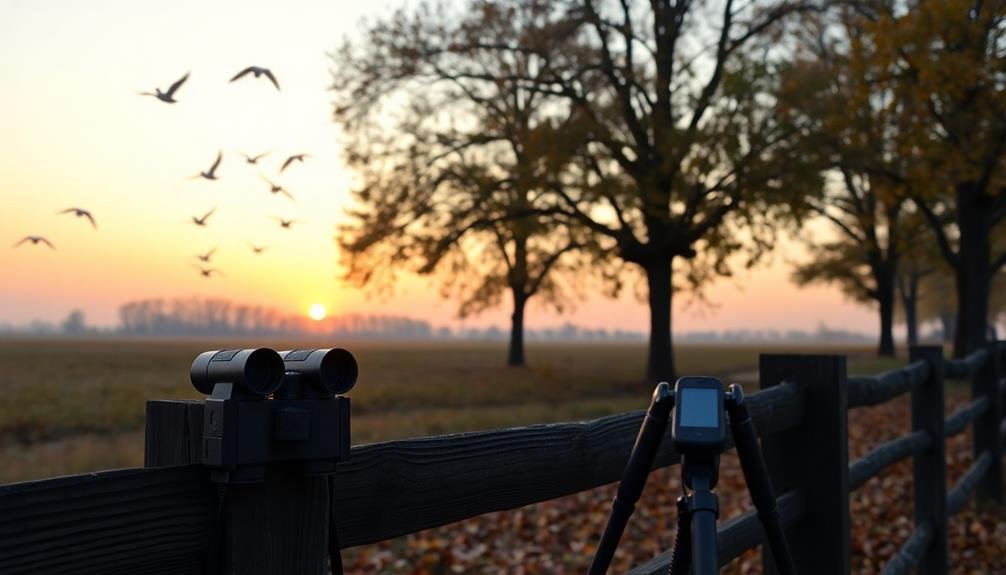To unwind with seasonal bird migration watching, start by understanding migration patterns and equipping yourself with binoculars and a field guide. Choose ideal locations like coastal hotspots, wetlands, or mountain passes, and time your excursions during peak migration periods. Learn to identify common migratory species and practice mindful observation techniques. Keep a journal to record your experiences and consider photographing the birds you encounter. Connect with fellow enthusiasts through local birding groups or online forums. Don't forget to support conservation efforts for migratory species. By embracing this hobby, you'll discover a world of natural wonder and relaxation.
Understanding Bird Migration Patterns

Why do birds commence on long, perilous journeys every year? The answer lies in their instinctual drive to find better conditions for breeding and feeding. As seasons change, birds follow predictable patterns, moving between their breeding and wintering grounds.
To understand these patterns, you'll need to familiarize yourself with common migration routes. In North America, four major flyways exist: the Pacific, Central, Mississippi, and Atlantic. Each flyway serves as a highway for various species, with some birds traveling thousands of miles.
Timing is vital in bird migration. Many species depart as days grow shorter and temperatures drop, while others respond to changes in food availability. You'll notice that different species migrate at different times, creating waves of migration throughout the season.
Weather plays a significant role in migration patterns. Birds often take advantage of tailwinds to conserve energy during their journey. They'll also adjust their routes to avoid storms or unfavorable conditions.
Essential Equipment for Bird Watching
Binoculars are the cornerstone of any bird watcher's toolkit. You'll want a pair with 8x or 10x magnification and 42mm objective lenses for ideal brightness and field of view.
Don't forget to invest in a comfortable neck strap to prevent fatigue during long observation sessions.
A field guide is essential for identifying the various species you'll encounter. Choose one specific to your region, with clear illustrations and detailed descriptions.
Many birders now opt for smartphone apps that offer interactive features and audio recordings of bird calls.
A sturdy notebook and pen are vital for recording your observations. Note the date, time, location, weather conditions, and species spotted.
This data will help you track migration patterns over time.
Dress appropriately for the weather and terrain. Wear comfortable, waterproof shoes and layer your clothing.
A wide-brimmed hat and sunglasses will protect you from glare and help you spot birds against bright skies.
Consider bringing a spotting scope for distant viewing, especially in open areas.
A good camera with a telephoto lens can capture memorable images of your feathered finds.
Ideal Locations for Migration Observation

When planning your bird migration watching excursion, you'll want to contemplate three key types of locations.
Coastal hotspots offer prime viewing of seabirds and shorebirds, while inland wetland areas attract diverse waterfowl species.
For an aerial spectacle, head to mountain passes where you can observe raptors and other soaring birds riding thermal currents during their journey.
Coastal Hotspots
Along the coasts, nature provides some of the best vantage points for observing seasonal bird migrations. You'll find that coastal areas offer unique advantages for bird watching due to their geography and the flight patterns of migratory birds. Many species follow coastlines as navigational aids, making these areas prime spots for sightings.
Head to popular coastal hotspots like Cape May in New Jersey, Point Reyes in California, or Hawk Mountain in Pennsylvania. These locations often feature elevated viewing platforms or natural promontories that give you expansive views of the sky and surrounding landscape.
You'll want to time your visit with peak migration periods, which typically occur in spring and fall.
Don't forget to check out coastal wetlands and estuaries, as they're essential stopover points for many bird species. Places like the Chesapeake Bay or the Gulf Coast of Texas attract diverse waterfowl and shorebirds.
Bring a good pair of binoculars and a field guide to help you identify the various species you'll encounter. Remember to dress appropriately for the weather and terrain, as coastal conditions can be unpredictable.
Inland Wetland Areas
Venture inland to discover prime bird-watching locations at wetland areas, which serve as essential pit stops for migrating species. These diverse ecosystems offer abundant food, shelter, and resting spots for birds on their long journeys.
You'll find a rich variety of waterfowl, shorebirds, and songbirds making use of these habitats during migration seasons. Look for national wildlife refuges, state parks, and nature preserves that feature wetlands, marshes, or swamps.
These protected areas often have well-maintained trails, boardwalks, and observation platforms that provide excellent vantage points for spotting birds. You'll want to bring binoculars and a field guide to help identify the different species you encounter.
Early mornings and late afternoons are typically the best times for bird watching, as many species are most active during these hours. Don't forget to check local birding reports or websites for recent sightings and migration updates.
Some popular inland wetland areas for migration watching include the Everglades in Florida, Horicon Marsh in Wisconsin, and the Great Salt Lake wetlands in Utah. Each offers unique opportunities to observe different migratory patterns and species.
Mountain Passes
Mountain passes offer unique vantage points for observing bird migration. These natural corridors funnel birds through narrow areas, concentrating their numbers and making them easier to spot. You'll find that many species use these routes to navigate between their breeding and wintering grounds.
To make the most of your mountain pass bird-watching experience, arrive early in the morning when activity is at its peak. Bring a good pair of binoculars and a field guide to help you identify the various species you'll encounter. Don't forget to dress in layers, as mountain weather can be unpredictable.
Some popular mountain passes for bird migration watching include Hawk Mountain in Pennsylvania, Kiptopeke State Park in Virginia, and Whitefish Point in Michigan. These locations are known for their impressive raptor migrations, but you'll also see a variety of songbirds and waterfowl.
Keep an eye out for thermals, rising columns of warm air that birds use to gain altitude with minimal energy expenditure. You'll often see raptors circling in these thermals before continuing their journey.
Timing Your Bird Watching Excursions
To maximize your bird watching experience, you'll want to align your excursions with peak migration periods.
Research local migration patterns for your area, as these can vary considerably by species and region.
Don't forget to take into account weather conditions, as they can greatly influence bird movement and visibility during their journeys.
Peak Migration Periods
Timing is essential when planning your bird watching excursions during migration seasons. To maximize your chances of spotting diverse species, you'll need to understand peak migration periods.
In North America, spring migration typically occurs from late February to early June, with April and May being the busiest months. Fall migration starts as early as July for some shorebirds and extends through December, peaking in September and October.
Different bird groups have varying migration schedules. Waterfowl and raptors often migrate earlier in spring and later in fall, while songbirds tend to move during the middle of each season. Coastal areas see shorebirds passing through in late summer and early fall.
To pinpoint specific timing for your region, consult local birding guides or online resources like eBird, which provide real-time migration data.
Weather patterns also influence peak migration periods. Birds often travel on the heels of cold fronts in fall and warm fronts in spring. Keep an eye on weather forecasts and be prepared to head out when conditions are favorable.
Local Migration Patterns
Understanding local migration patterns is key to successful bird watching during peak seasons. To make the most of your bird watching excursions, familiarize yourself with the specific routes and timing of bird movements in your area. Research local birding hotspots and consult regional bird guides to identify which species you're likely to encounter.
Pay attention to weather patterns, as they greatly influence bird migration. Cold fronts and tailwinds can trigger mass movements, while headwinds may cause birds to delay their journeys. Keep an eye on local weather forecasts and plan your outings accordingly.
Here's a quick reference guide for common migration patterns:
| Season | Direction | Common Species | Best Time | Habitat |
|---|---|---|---|---|
| Spring | Northward | Warblers, Thrushes | Dawn | Woodlands |
| Fall | Southward | Raptors, Waterfowl | Midday | Open fields, Lakes |
| Winter | Varies | Finches, Owls | Dusk | Forests, Grasslands |
| Summer | Local | Swallows, Flycatchers | Early morning | Wetlands, Meadows |
| Year-round | Varies | Resident birds | Anytime | Urban parks, Backyards |
Weather and Timing
Three key factors determine the ideal timing for your bird watching excursions: weather conditions, time of day, and season. For best viewing, choose days with clear skies and mild temperatures. Avoid extreme weather, as birds are less active during heavy rain, strong winds, or intense heat.
Early morning and late afternoon are prime times for bird activity, especially during migration seasons.
Spring and fall migrations offer the best opportunities to observe a variety of species. In spring, watch for birds returning from their southern wintering grounds, typically from March to May. Fall migration occurs from August to November, as birds head south for winter.
Keep an eye on local weather forecasts and bird migration reports to pinpoint peak movement days.
You'll want to time your outings with the natural rhythms of bird behavior. Many species are most active at dawn and dusk, known as the "golden hours" for bird watching.
During hot summer days, birds may seek shelter and become less visible. In winter, focus on areas where birds congregate for food and warmth, such as feeders or sheltered spots.
Identifying Common Migratory Species

Recognizing common migratory species is a crucial skill for any bird enthusiast. As you begin your bird-watching journey, focus on learning to identify some of the most frequent visitors to your area during migration seasons. Start by familiarizing yourself with the distinct features of birds like warblers, thrushes, and waterfowl.
To improve your identification skills, follow these steps:
- Study field guides and online resources to learn about the physical characteristics, calls, and behaviors of common migratory birds in your region.
- Practice using binoculars to observe birds at a distance, paying attention to details like wing patterns, beak shape, and overall size.
- Keep a bird journal to record your observations, including dates, locations, and any unique features you notice.
Don't get discouraged if you can't immediately identify every bird you see. With time and practice, you'll develop a keen eye for distinguishing between different species.
Pay attention to subtle differences in coloration, flight patterns, and habitat preferences. Listen carefully to bird calls and songs, as these can often be more reliable identifiers than visual cues alone.
Mindful Observation Techniques
Mindful observation techniques can take your bird-watching experience to the next level. Start by focusing on your breath and grounding yourself in the present moment.
As you scan the sky or trees, maintain a relaxed alertness, allowing your eyes to softly take in the entire scene rather than darting around frantically.
When you spot a bird, resist the urge to immediately identify it. Instead, observe its behavior, movements, and interactions with its environment. Notice the bird's shape, size, and colors without judgment.
Listen carefully to its calls or songs, paying attention to pitch, rhythm, and duration.
Use all your senses to enhance your experience. Feel the breeze on your skin, smell the surrounding nature, and even taste the air. This multi-sensory approach will help you connect more deeply with the birds and their habitat.
Practice patience and stillness. Birds are more likely to appear and behave naturally when you're calm and quiet.
If you're using binoculars, hold them steady and move slowly to avoid startling the birds.
Journaling Your Bird Watching Experiences

Keeping a bird watching journal is an invaluable tool for enhancing your experience and knowledge. It allows you to track your observations, document species sightings, and reflect on your encounters with nature. As you commence on your seasonal bird migration watching journey, consider incorporating journaling into your routine.
Start by choosing a format that works best for you, whether it's a traditional notebook, a digital app, or a combination of both. Record key details such as date, time, location, weather conditions, and species observed. Don't forget to note any unusual behaviors or interactions you witness.
To make the most of your bird watching journal:
- Sketch or photograph birds you encounter, focusing on distinguishing features.
- Include maps or GPS coordinates to pinpoint specific observation spots.
- Reflect on your emotional responses and personal growth as a bird watcher.
Connecting With Fellow Bird Enthusiasts
Through connecting with fellow bird enthusiasts, you'll enrich your seasonal migration watching experience. Start by joining local birding groups or clubs, which often organize field trips and events during peak migration periods. These outings provide opportunities to learn from experienced birders and share your own observations.
Participate in online forums and social media groups dedicated to bird watching. These platforms allow you to connect with enthusiasts worldwide, share photos, and discuss sightings. You'll gain valuable insights into migration patterns and hotspots you might've otherwise missed.
Consider attending bird festivals or conferences, which often coincide with migration seasons. These events offer workshops, lectures, and guided tours led by experts in the field. You'll expand your knowledge and network with like-minded individuals who share your passion.
Volunteer for citizen science projects focused on bird migration. Programs like eBird and Project FeederWatch rely on data collected by amateur birders. By contributing, you'll help researchers track migration patterns and population trends while connecting with a broader community of bird enthusiasts.
Don't hesitate to strike up conversations with other birders you encounter in the field. Sharing tips and sightings can lead to lasting friendships and memorable birding experiences.
Photography Tips for Migratory Birds

As migratory birds take flight, capturing their beauty on camera requires skill and preparation. You'll need to invest in the right equipment, including a camera with a fast shutter speed and a telephoto lens to zoom in on distant subjects. Learn to anticipate bird behavior and movements to capture the perfect shot. Practice your timing and be patient, as birds can be unpredictable.
To improve your migratory bird photography skills, focus on these key areas:
- Lighting: Shoot during the golden hours of early morning or late afternoon for warm, soft light. Position yourself with the sun at your back to illuminate your subjects.
- Composition: Apply the rule of thirds, leaving space for birds to "fly into" the frame. Include environmental context to tell a story about the bird's habitat.
- Camera settings: Use a high ISO to compensate for low light, and a wide aperture for a shallow depth of field. Set your camera to continuous shooting mode to capture rapid movements.
Remember to respect wildlife and maintain a safe distance. Don't disturb nesting areas or use flash photography, which can stress birds.
With practice and persistence, you'll soon be capturing stunning images of migratory birds in flight.
Conservation Efforts for Migratory Species
Faced with numerous threats, migratory bird species require dedicated conservation efforts to guarantee their survival. You can play a vital role in protecting these birds by supporting organizations focused on habitat preservation and restoration. Consider donating to or volunteering with groups like the Audubon Society or BirdLife International.
You'll make a significant impact by creating bird-friendly spaces in your own backyard. Plant native species that provide food and shelter for migrating birds. Avoid using pesticides, which can harm birds directly or reduce their food sources. Keep cats indoors, as they're a major threat to bird populations.
During migration seasons, you can help by turning off unnecessary lights at night. Many birds migrate after dark and can become disoriented by artificial lighting.
Participating in citizen science projects, such as eBird, allows you to contribute valuable data on bird populations and movements.
Lastly, advocate for policies that protect migratory birds and their habitats. Support legislation aimed at reducing climate change impacts and preserving essential stopover sites along migration routes. Your voice can make a difference in ensuring these incredible journeys continue for generations to come.
Frequently Asked Questions
How Can I Differentiate Between Resident and Migratory Birds?
You can differentiate resident and migratory birds by observing their presence year-round. Resident birds stay in one area, while migratory birds appear seasonally. Check field guides, note arrival times, and watch for behavioral changes to identify migrants.
Are There Any Health Risks Associated With Bird Watching During Migration Seasons?
While bird watching during migration seasons, you're generally safe. However, you'll want to watch out for tick-borne diseases, sunburn, and dehydration. Always wear protective clothing, use insect repellent, and stay hydrated when you're outdoors.
What Should I Do if I Encounter an Injured Migratory Bird?
If you find an injured migratory bird, don't try to handle it yourself. Contact a local wildlife rehabilitator or animal control immediately. Keep the bird warm and quiet, but don't give it food or water. Minimize stress for the bird.
How Does Climate Change Affect Bird Migration Patterns?
Climate change alters bird migration patterns considerably. You'll notice birds arriving earlier, leaving later, or changing routes entirely. Some species may stop migrating altogether, while others face challenges finding food and suitable habitats along their journey.
Can Bird Watching Negatively Impact Migratory Species or Their Habitats?
Yes, bird watching can negatively impact migratory species if you're not careful. You'll disturb birds if you get too close, use flash photography, or play recordings. Your presence can also damage fragile habitats, so always follow responsible birding guidelines.
In Summary
You've now got the tools to commence your seasonal bird migration watching journey. Remember, it's not just about spotting birds; it's about unwinding and connecting with nature. As you hone your skills, you'll find yourself enthusiastically anticipating each migration season. Don't forget to share your experiences and contribute to conservation efforts. With patience and practice, you'll soon be identifying species like a pro and creating lasting memories in the great outdoors.





Leave a Reply